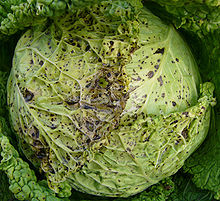| Tymovirus | |
|---|---|
 | |
| Turnip yellow mosaic virus on cabbage, found in Bělidla, Olomouc, Moravia, Czech Republic | |
| Virus classification | |
| (unranked): | Virus |
| Realm: | Riboviria |
| Kingdom: | Orthornavirae |
| Phylum: | Kitrinoviricota |
| Class: | Alsuviricetes |
| Order: | Tymovirales |
| Family: | Tymoviridae |
| Genus: | Tymovirus |
Tymovirus is a genus of viruses in the order Tymovirales , in the family Tymoviridae . Plants serve as natural hosts. There are 30 species in this genus. [1] [2]